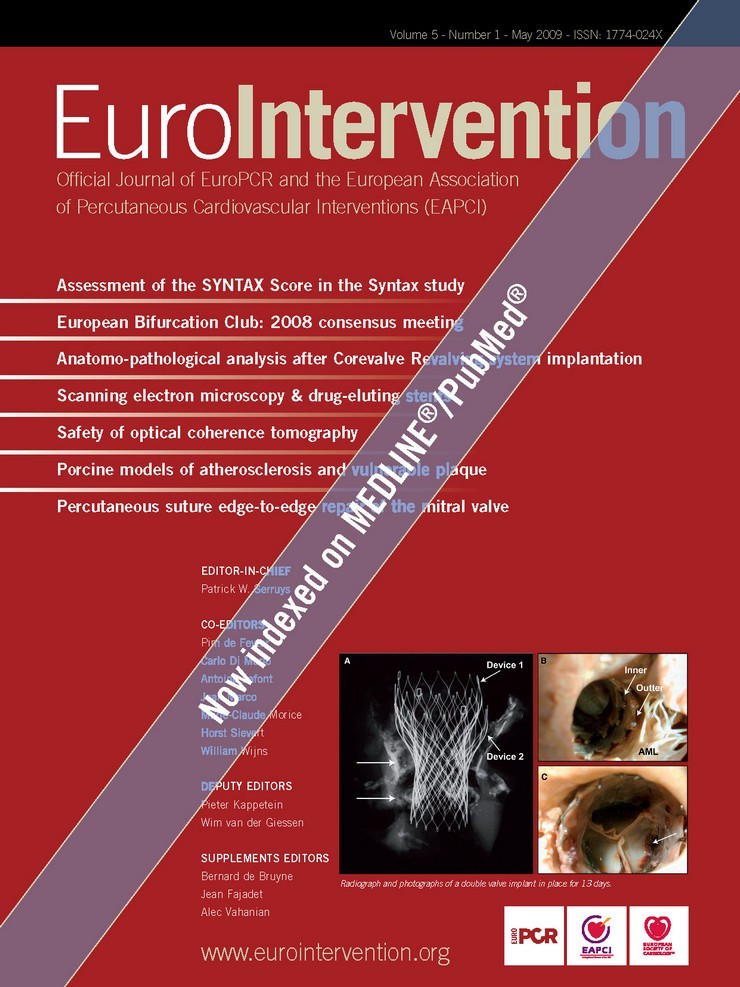Prior to embarking on surgery, cardiac surgeons routinely score their patients for perioperative risk1-3. Risk scoring forms an integral part of the informed consent process such that the patient has some idea as to the likely risks associated with the procedure, and the surgeon can assess the individual risk of the patient judged objectively against a large body of outcome data. In addition, risk scores allow clinical investigators to make valid comparisons and assess outcomes between different patient groups who have been stratified for risk.
It is clear that a scoring system would also be useful to the interventional cardiologist, particularly as they continue to explore the interface between percutaneous techniques and conventional cardiac surgery in patients with complex coronary anatomy. The limitations of defining patients as having one-, two- and three-vessel disease are obvious, as this high-level classification gives no idea as to the complexity or the challenges of the procedure which will vary according to the presence or absence of a number of anatomic factors including bifurcations, chronic occlusions, tortuosity, calcification, diffuse disease etc.
The SYNTAX Score is an angiographic tool for grading the complexity of coronary artery disease4. Unlike previous scoring systems, the SYNTAX Score is applied to the complete coronary artery tree, and in the SYNTAX trial was calculated and agreed a priori, and signed off by the Heart Team consisting of a cardiac surgeon and interventional cardiologist before embarking on the revascularisation procedure5. Importantly, the SYNTAX Score reflects the coronary anatomy, and not the treatment strategy.
At one year of follow-up in the 1,800 patients randomised in the SYNTAX trial, PCI outcomes were reflected in the SYNTAX Score5. In patients with low scores (0-22) adverse event rates (MACCE) were similar in the PCI and CABG groups (13.5% vs. 14.4%, p=0.71 respectively); in the mid-score tertile (23-32), MACCE was not statistical different between treatment strategies (PCI 16.6% vs. CABG 11.7%, p=0.10); whereas in the most complex patients with the highest scores (≥33), the outcome in the CABG group was superior to PCI (PCI 23.3% vs. CABG 10.7%, p<0.001). Thus, in patients with left main stem and/or three vessel disease treated with PCI in the SYNTAX trial, the SYNTAX Score was not only a useful descriptive tool, but also was predictive of outcomes at one year. The SYNTAX Score was not a significant outcome discriminator in the CABG group; this is not surprising as surgical morbidity and mortality is more determined by comorbidity (e.g. presence or absence of COPD, renal impairment, stroke history etc.) rather than the coronary anatomy per se. In surgical patients, risk is more reliably reflected in scoring systems that include co-morbidity, for example the EuroSCORE and Parsonnet scores1,2. In this edition of EuroIntervention, Serruys and colleagues confirm the value and reproducibility of the SYNTAX Score in risk stratifying the one-year outcomes of the patients randomised to PCI in the SYNTAX trial6.
The SYNTAX Score has already been retrospectively applied to other patient groups, for example ARTS II7, there is every expectation that the scoring tool will find widespread applicability in many other studies, and it will also be useful as a risk assessment tool in institutions undertaking coronary revascularisation. This edition of EuroIntervention is accompanied by a SYNTAX Score CD, which includes a tutorial with examples of how to apply the SYNTAX Score, a scoring tool, as well as PowerPoint presentations of the SYNTAX data. Coincident with EuroPCR 2009, the SYNTAX Score website will be launched on-line at http://syntaxscore.com. This will include the SYNTAX Score tutorial, scoring tool and presentations, and will allow for constant updates as more SYNTAX trial data become available. There is an expectation that further refinements will include the development of a Logistic SYNTAX Score, to integrate a limited number of comorbidities to the coronary anatomy (e.g. the presence of diabetes), as well as the ability to remotely update encrypted patient data to numerically increase the power of the database.

